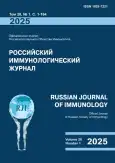Показатели системного воспаления при геморрагическом инсульте с эффективным кровотоком: динамическое наблюдение
- Авторы: Соломатина Л.В.1, Бочкарев П.Ю.2, Береснева Н.С.2, Зудова А.И.1, Гусев Е.Ю.1
-
Учреждения:
- ФГБУН «Институт иммунологии и физиологии» Уральского отделения Российской академии наук
- ГАУЗ Свердловской области «Свердловская областная клиническая больница № 1»
- Выпуск: Том 28, № 1 (2025)
- Страницы: 117-122
- Раздел: КРАТКИЕ СООБЩЕНИЯ
- URL: https://bakhtiniada.ru/1028-7221/article/view/277350
- DOI: https://doi.org/10.46235/1028-7221-16979-IOS
- ID: 277350
Цитировать
Полный текст
Аннотация
Все больше данных свидетельствуют о том, что инсульт является системным заболеванием, поражающим многие системы органов. При этом связанные с геморрагическим инсультом системная воспалительная реакция и иммунная дисрегуляция могут играть важную роль в травме головного мозга, выздоровлении и исходе инсульта. Но стоит отметить, что классические представления о воспалении в патофизиологии и общей патологии, с нашей точки зрения, не отвечают потребностям современной медицинской практики. Наличие этой проблемы характерно как для оценки патогенеза, так и для оптимизации патогенетической терапии тяжелых инсультов. Поэтому в рамках данной работы произведено динамическое наблюдение и оценка патогенеза тяжёлого внутримозгового кровоизлияния с помощью критериев шкалы системного воспаления. В исследование были включены пациенты с внутримозговым кровоизлиянием и с эффективным мозговым кровотоком. Забор крови производился на 1-3-и и 5-7-е сутки после манифестации внутримозгового кровоизлияния. Для определения маркеров системного воспаления в плазме крови пациентов исследовали уровни IL-6, IL-8, IL-10, TNFá, прокальцитонина, кортизола, миоглобина, тропонина I и D-димеров с помощью иммуноферментного анализа. Критерий Колмогорова–Смирнова использовался для подтверждения нормальности распределения данных. Дальше сравнение количественных данных проводилось с использованием непараметрического критерия Вилкоксона для парных сравнений. Все результаты считались статистически значимыми при p < 0,05. У пациентов с внутримозговым кровоизлиянием на 1-3-и и 5-7-е сутки статистически значимые различия не отмечались практически по всем исследуемым маркерам системного воспаления, кроме IL-8 и фактора некроза опухоли-á. Такое увеличение содержания провоспалительных цитокинов может указывать на усиление системного воспаления в динамике при внутримозговом кровоизлиянии и эффективном мозговом кровотоке. Следовательно, состояние таких пациентов может ухудшаться на 5-7-е сутки после манифестации внутримозгового кровоизлияния, что требует большего контроля за показателями крови у пациентов и терапии, направленной на подавление усиливающегося воспаления.
Ключевые слова
Полный текст
Открыть статью на сайте журналаОб авторах
Лилия Владимировна Соломатина
ФГБУН «Институт иммунологии и физиологии» Уральского отделения Российской академии наук
Автор, ответственный за переписку.
Email: slv10@list.ru
к.м.н., старший научный сотрудник лаборатории иммунологии воспаления
Россия, г. ЕкатеринбургПётр Юрьевич Бочкарев
ГАУЗ Свердловской области «Свердловская областная клиническая больница № 1»
Email: slv10@list.ru
заведующий отделением лабораторной диагностики
Россия, г. ЕкатеринбургНаталия Сергеевна Береснева
ГАУЗ Свердловской области «Свердловская областная клиническая больница № 1»
Email: slv10@list.ru
врач отделения лабораторной диагностики
Россия, г. ЕкатеринбургАлевтина Игоревна Зудова
ФГБУН «Институт иммунологии и физиологии» Уральского отделения Российской академии наук
Email: slv10@list.ru
врач отделения лабораторной диагностики
Россия, г. ЕкатеринбургЕвгений Юрьевич Гусев
ФГБУН «Институт иммунологии и физиологии» Уральского отделения Российской академии наук
Email: slv10@list.ru
младший научный сотрудник лаборатории иммунологии воспаления
Россия, г. ЕкатеринбургСписок литературы
- Fajgenbaum D.C., June C.H. Cytokine Storm. N Engl J Med., 2020, Vol. 383, no. 23, pp. 2255-2273. doi: 10.1056/NEJMra2026131.
- Gusev E., Zhuravleva Y. Inflammation: A New Look at an Old Problem. Int J Mol Sci. 2022, Vol. 23, no. 9, p. 4596. doi: 10.3390/ijms23094596.
- Knight-Greenfield A., Nario J.J.Q., Gupta A. Causes of Acute Stroke: A Patterned Approach. Radiol Clin North Am. 2019, Vol. 57, no. 6, pp. 1093-1108. doi: 10.1016/j.rcl.2019.07.007.
- Ohashi S.N., DeLong J.H., Kozberg M.G., Mazur-Hart D.J. et al. Role of Inflammatory Processes in Hemorrhagic Stroke. Stroke. 2023, Vol. 54, no. 2, pp. 605-619. doi: 10.1161/STROKEAHA.122.037155.
- Saand A.R., Yu F., Chen J., Chou S.H. Systemic inflammation in hemorrhagic strokes - A novel neurological sign and therapeutic target? J Cereb Blood Flow Metab. 2019, Vol. 39, no. 6, pp. 959-988. doi: 10.1177/0271678X19841443.
- Yang Q., Tong X., Schieb L., Vaughan A. et al. Vital Signs: Recent Trends in Stroke Death Rates - United States, 2000-2015. MMWR Morb Mortal Wkly Rep. 2017, Vol. 66, no. 35, pp. 933-939. doi: 10.15585/mmwr.mm6635e1.
Дополнительные файлы








